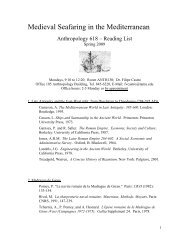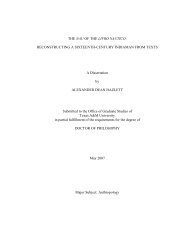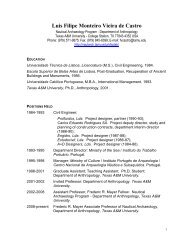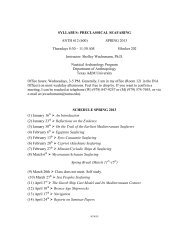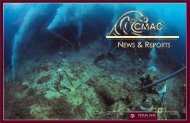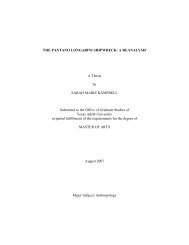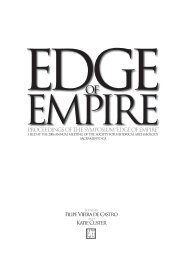Download Pdf of Dissertation - Nautical Archaeology at Texas A&M ...
Download Pdf of Dissertation - Nautical Archaeology at Texas A&M ...
Download Pdf of Dissertation - Nautical Archaeology at Texas A&M ...
You also want an ePaper? Increase the reach of your titles
YUMPU automatically turns print PDFs into web optimized ePapers that Google loves.
the former kings <strong>of</strong> Bithynia, though whether this was intended to drain the<br />
surrounding fields or to connect the lake with the river I am not sure; it was left<br />
unfinished, and again I cannot say if this was because the king died suddenly or<br />
despaired finishing the work. (B. Radice).<br />
Plin. Ep. 10.42: TRAIAUS PLIIO. Potest nos sollicitare lacus iste, ut committere<br />
illum mari velimus; sed plane explorandum est diligenter, ne si emissus in mare fuerit<br />
totus efflu<strong>at</strong> certe, quantum aquarum et unde accipi<strong>at</strong>. Poteris a Calpurnio Macro<br />
petere libr<strong>at</strong>orem, et ego hinc aliquem tibi peritum eius modi operum mittam.<br />
Trajan to Pliny. “I may perhaps be tempted to think <strong>of</strong> connecting this lake <strong>of</strong><br />
yours with the sea, but there must be first be an accur<strong>at</strong>e survey to find how much<br />
w<strong>at</strong>er the lake contains and from wh<strong>at</strong> source it is filled, or else it might be completely<br />
drained once it is given an outlet to the sea. You can apply to Calpurnius Macer for an<br />
engineer, and I will send you out someone who has experience <strong>of</strong> this sort <strong>of</strong> work. (B.<br />
Radice).<br />
Plin. H 3.10.95-6: A Locris Italiae frons incipit Magna Graecia appell<strong>at</strong>e, in tris sinus<br />
recedens Ausonii maris, quoniam Ausones tenuere primi. P<strong>at</strong>et LXXXVI, ut auctor est<br />
Varro; plerique LXXV fecere. In ea ora flumina innumera, sed memor<strong>at</strong>u dignu a Locris<br />
Sagra et vestigia oppidi Caulonis, Mustiae, Consilinum castrum, Cocynthum quod esse<br />
longissimum Italiae promontorium aliqui existumant, dein sinus et urbs Scolagium,<br />
Scylletium Atheniensibus cum conderent dictum; quem locum occurrens Terinaeus sinus<br />
peninsulam efficit, et in ea portus qui voc<strong>at</strong>ur Castra Hannibalis, nusquam angustiore<br />
Italia: XX p. l<strong>at</strong>itudo est. itaque Dionysius maior intercisam eo loco adicere Siciliae voluit.<br />
Amnes ibi navigabiles Carcinus, Crotalus, Semirus, Arogas, Thagines, oppidum intus<br />
Petilia, mons Clibanus, promunturium Lacinium, cuius ante oram insula X a terra<br />
Dioscoron, altera Calypsus quam Ogygiam appellasse Homerus existim<strong>at</strong>ur, praeterea<br />
Tyris, Eranusa, Meloessa, ipsum a Caulone abesse LXX prodit Agrippa.<br />
At Locri begins the projection <strong>of</strong> Italy called Magna Graecia, retiring into the three<br />
bays <strong>of</strong> the Ausonian Sea, so called from the first inhabitants the Ausones. According to<br />
Varro its length is 86 miles, but most authorities have made it 75. On this coast are rivers<br />
beyond count; but the places worthy <strong>of</strong> mention, beginning <strong>at</strong> Locri, are the Sagra River<br />
and the ruins <strong>of</strong> Caulonia’s higher city, then Monasterace, Camp Consilinum, Punta Stilo<br />
(thought by some to be the longest promontory in Italy), then the gulf and city <strong>of</strong><br />
Scolacium, called by the Athenians when founded it Skylletion. This part <strong>of</strong> the country is<br />
made into a peninsula by the Gulf <strong>of</strong> Santa Eufemia which runs up to it, and on it is the<br />
harbour called Hannibal’s camp. It is the narrowest part <strong>of</strong> Italy, which is here 20 miles<br />
across, and consequently the elder Dionysius wanted to cut a canal across the peninsula in<br />
this place, and annex it to Sicily. The navigable rivers in this district are the Corace, Alli,<br />
Simari, Crocchio, and Tacina; it contains the inland town <strong>of</strong> Strongoli, the range <strong>of</strong> the<br />
Monte Monacello, and the promontory <strong>of</strong> Lacinium, <strong>of</strong>f the coast <strong>of</strong> which ten miles out<br />
lies the Island <strong>of</strong> the Sons <strong>of</strong> Zeus and another called Calypso’s Island, which is thought to<br />
be Homer’s island <strong>of</strong> Ogygia, and also Tyris, Eranusa and Meloessa. According to Agrippa<br />
the distance <strong>of</strong> the promontory <strong>of</strong> Lacinium from Caulon is 70 miles. (H. Rackham).<br />
319





